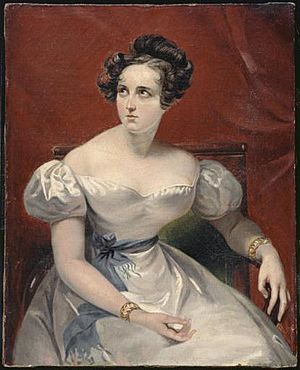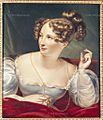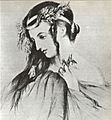Harriet Smithson facts for kids
Quick facts for kids
Harriet Constance Smithson
|
|
|---|---|

Harriet Smithson by Dubufe, c. 1828. Musee Magnin, Dijon
|
|
| Born |
Harriet Constance Smithson
18 March 1800 |
| Died | 3 March 1854 (aged 53) Paris, France
|
| Occupation | Shakespearean actress |
| Years active | 1814–1837 |
| Spouse(s) |
Hector Berlioz
(m. 1833; died 1854) |
Harriet Constance Smithson (born March 18, 1800 – died March 3, 1854) was a famous Anglo-Irish actress from the 1800s. She was best known for her amazing performances in Shakespeare plays. Harriet also became the first wife and inspiration (or 'muse') for the famous French composer Hector Berlioz.
Contents
Harriet Smithson's Early Life
Harriet Smithson was born in Ennis, County Clare, Ireland, on March 18, 1800. Her father, William Joseph Smithson, was an actor and theatre manager. Her mother was also an actress.
When Harriet was very young, in 1801, she was left in the care of Reverend James Barrett. He was a priest who raised her as his own daughter. He taught her about religion and kept her away from anything to do with the stage. After Reverend Barrett passed away in 1808, Harriet went to a boarding school in Waterford.
Harriet Smithson's Acting Career
Starting in Ireland
Harriet Smithson made her first stage appearance on May 27, 1814. She was just 14 years old. This happened at the Theatre Royal in Dublin. She played the role of Albina Mandevill in a play called The Will.
Her performance was very well received. A newspaper called the Freeman's Journal gave her a positive review. They said she was a "most interesting and promising young actress." In 1815, Harriet joined Montague Talbot's theatre company in Belfast. She performed in many comedies and other plays. She then traveled to other cities like Limerick and Birmingham.
First Performances in London
Four years later, on January 20, 1818, Harriet performed in London for the first time. She appeared at Drury Lane theatre. Her first performance received mixed reviews from critics. However, as she gained more experience, she quickly became more popular with critics and other actors.
She later joined the Royal Coburg theatre company. Then, in 1820, she returned to the Drury Lane Company. In 1821, she took on the main female role in a play called Thérèse. This happened when the original actress became ill. Overall, London audiences remembered her as a good actress, but not a huge star.
Becoming Famous in Paris
In 1827, Harriet Smithson performed in Paris for the first time. She acted in a play called The Rivals at the Odéon theatre. Even though she got some negative reviews for this role, people praised her beauty and talent in her next play, She Stoops to Conquer.
On September 11, 1827, she played a small but important part. She was Ophelia in Shakespeare's Hamlet. Her performance of Ophelia's madness left a lasting impression on the French audience. She used body language and natural acting to show Ophelia's feelings.
People said that her acting was full of "grace and truth." They especially liked how she used pantomime (acting without words). This new style of acting was very natural and powerful.
The huge success of Hamlet led to another Shakespeare play, Romeo & Juliet, on September 15. Harriet played Juliet. She changed how women's roles were seen in theatre. She made Juliet as important as Romeo. Before this, women's lines were often cut short. This production was also very popular.
One critic wrote that "Miss Smithson could not have been more graceful upon the balcony." They said her acting was full of "truth, grace, and love."
On September 18, Shakespeare's Othello was performed. Harriet played Desdemona. Her performance was less powerful, but the play was still popular.
The English Theatre then showed comedies. But the press wanted more tragedies. So, they put on The Tragedy of Jane Shore. Harriet played Shore and made her audience cry. This play became the most performed play of the English season. By the end of her time in France, she had acted with famous actors like William Charles Macready and Edmund Kean.
Harriet became famous for her natural acting style. She showed French audiences new English theatre methods. These methods allowed her to truly become her characters. This new style, which focused on drama and truth, was very popular with French Romantics. Soon, many French actresses started to copy her way of acting.
Returning to London
Harriet returned to London in 1829. She performed Jane Shore again at Covent Garden. Some people in London were not sure about her acting. They remembered her earlier, less positive reviews. However, after her next performance as Juliet, the press gave her great reviews.
The Examiner newspaper wrote that her performance of Juliet was "by many degrees the best we have seen." They called her "the best tragic actress now in London."
She continued to perform in various plays in London and toured England. In 1832, she joined the Theatre Royal, Haymarket. However, she had less success there and faced some criticism about her weight.
End of Her Career
In 1830, Harriet went back to Paris. She tried to manage her own English theatre. She performed several plays, but they were not very successful. A year later, she broke her leg. This forced her to stop acting until her leg healed. She was in a lot of debt, and her mother and sister still relied on her for money.
Harriet gave her last performance as Ophelia on December 15, 1836. After this, her health got worse.
Harriet Smithson as an Inspiration
Harriet Smithson's real and powerful acting made her very famous. Before her, tragic roles were mostly for men. Her unique way of playing characters, sometimes even a bit wild, opened the door for other actresses in tragedies. She set a new standard for great acting for everyone.
Her amazing acting made people mix up her real personality with the characters she played. At the peak of her career, she became a symbol for the French Romantic movement. Many French artworks, plays, music, and books were inspired by her. They often showed her as Ophelia, Juliet, or just as Harriet.
The most famous work she inspired was Hector Berlioz's Symphonie Fantastique. Berlioz saw Harriet as Ophelia in 1827. He became completely fascinated by her. His strong feelings led him to compose the Symphonie Fantastique. This symphony is known as the first great romantic symphony.
Marriage to Hector Berlioz
Hector Berlioz fell in love with Harriet after seeing her perform as Juliet and Ophelia. He sent her many letters, even though they had never met. He even lived in an apartment where he could watch her go home. Harriet ignored him for a long time.
But in 1832, a friend invited her to a performance of Lélio. This was a follow-up to Berlioz's Symphonie Fantastique. She realized the symphony was about her and sent him a message. Berlioz quickly got permission to meet her, and they became a couple.
Even though both their families and friends were against it, they got married. The wedding was at the British Embassy in Paris on October 3, 1833. Their only child, a son named Louis, was born on August 14, 1834.
Harriet soon became unhappy and jealous of Berlioz. His musical success meant he spent less time with her. As her health got worse, Berlioz started a relationship with another singer, Marie Recio. Harriet moved out of their home in 1843. However, Berlioz continued to support her financially.
Harriet Smithson's Death
Towards the end of her life, Harriet Smithson suffered from paralysis. This made it very hard for her to move or speak. She passed away on March 3, 1854, at her home in Paris. She was first buried at the Cimetière Saint-Vincent. Later, Berlioz had her body moved to the Montmartre cemetery.
Harriet Smithson's Theatrical Roles
| Year | Title | Role | Playwright |
|---|---|---|---|
| 1814 | The Will | Albina Mandevill | Frederick Reynolds |
| 1816 | The School for Scandal | Lady Teazle | Richard Brinsley Sheridan |
| 1816 | Laugh When You Can | Mrs. Mortimer | Frederick Reynolds |
| 1816 | Lover's Vows | Amelia | Elizabeth Inchbald |
| 1816 | The Mountaineers | Floranthe | George Coleman |
| 1816 | The Stranger | Mrs. Haller | August von Kotzebue |
| 1827 | Ben Nazir, the Saracen | Bathilda | Thomas Colley Grattan |
Images for kids
-
Harriet Smithson, by George Clint, as Miss Dorillon, in "Wives as They Were, and Maids as They Are",
See also
 In Spanish: Harriet Smithson para niños
In Spanish: Harriet Smithson para niños








